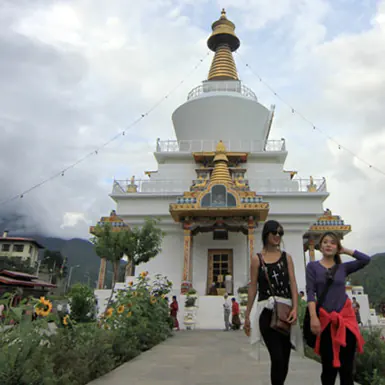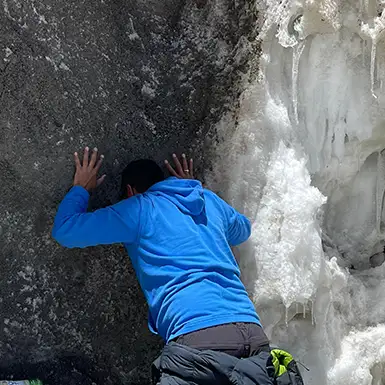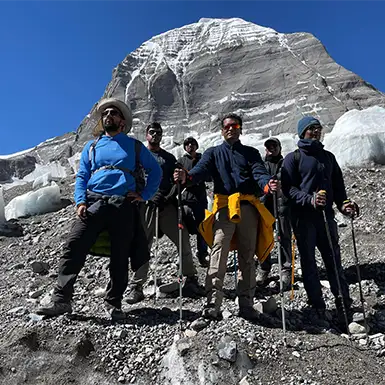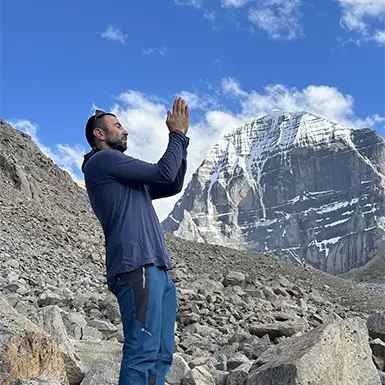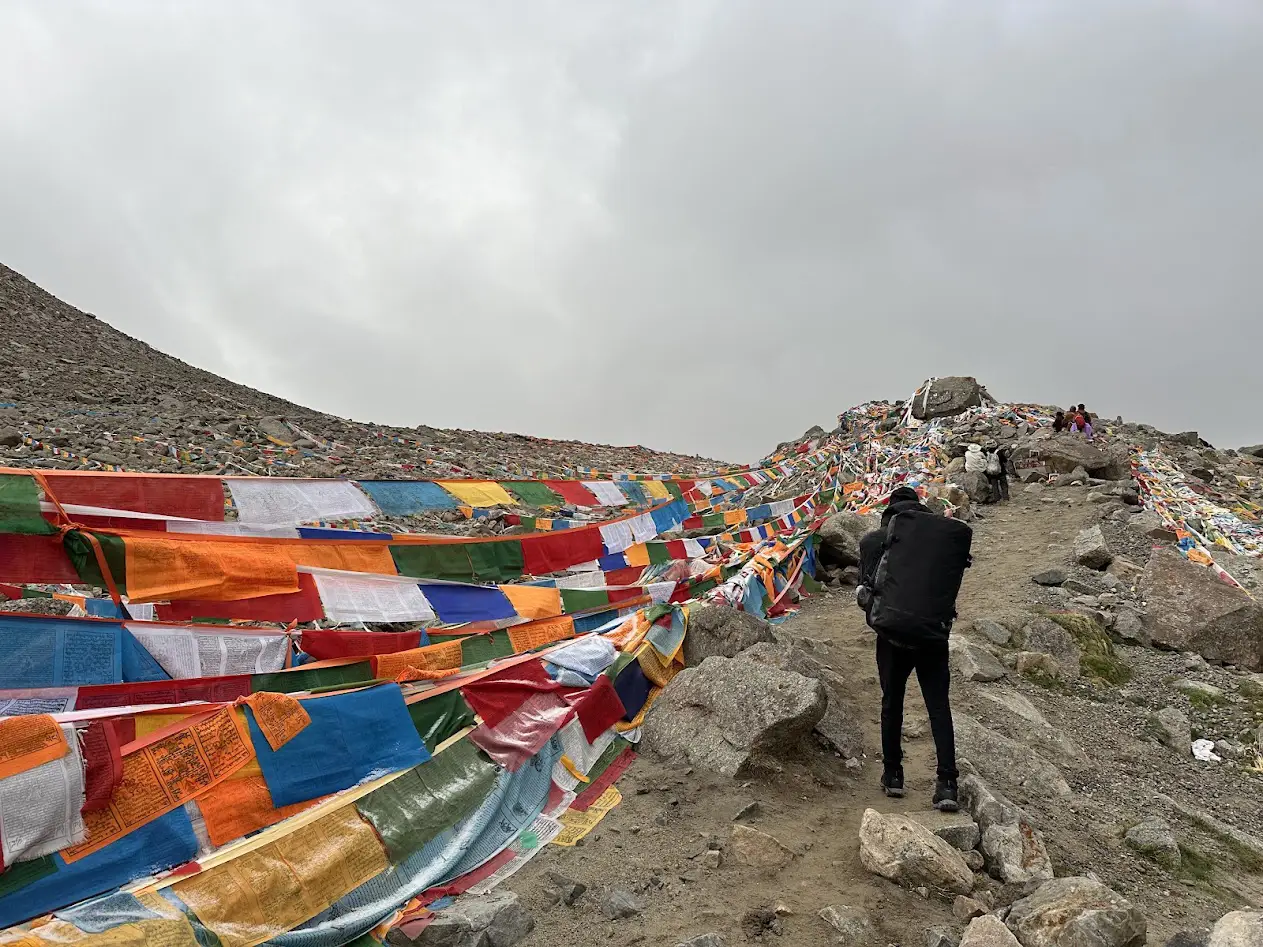3. The Elusive Kailash: Does the Mountain Shift and Change?
Mount Kailash legends, spiritual beliefs, sacred traditions, and mysteries weave a captivating tapestry around the mountain’s allure. The claim that Mount Kailash shifts its position regularly, making it difficult to map or climb, ranks among the most intriguing Kailash mysteries.
Legends of a Wandering Mountain
Tales abound of climbers and pilgrims who lose their way on Mount Kailash Kora, the circumambulation route around the mountain’s base. Some describe feeling disoriented as if the landscape has shifted around them. Others claim that the mountain appears to move, changing its position relative to the stars.
- Milarepa’s Ascent: One of the most famous Mount Kailash legends involves the 11th-century Tibetan yogi and poet Milarepa. He was the only person to reach the summit successfully, navigating the mountain’s shifting nature through his spiritual prowess.
- Disappearing Paths: Some pilgrims and explorers have reported paths that vanish unexpectedly, only to reappear in different locations. Some believe Kailash intentionally hides itself from those it considers undeserving.
The Scientific Perspective: Lack of Evidence
Despite these captivating stories, no scientific evidence supports the claim that Mount Kailash physically changes its position. Modern mapping technologies and GPS systems have not detected any such movement.
- Optical Illusions: Some scientists speculate that the reported changes in position may be optical illusions caused by the unique light and shadow play on the mountain’s faces or by the challenging high-altitude conditions that can affect perception.
- Psychological Phenomena: Some attribute the disorientation experienced by certain pilgrims to the psychological impact of the challenging pilgrimage and the high altitude.
The Enduring Allure of the Mystery
Despite lacking scientific proof, Mount Kailash’s facts and legends surrounding its shifting nature continue to captivate and intrigue. They add another layer of mystery to this sacred mountain, fueling the sense of wonder that draws countless pilgrims and adventurers to its slopes.
4. Unveiling Mount Kailash’s Mysterious Geographical Measurements
Mount Kailash facts, encompassing captivating phenomena and geographical wonders, transcend religious beliefs and the intriguing Mount Kailash legends. They delve into intriguing geographical measurements that have puzzled scientists and captivated spiritual seekers. These measurements, often linked to numerology and sacred geometry, add another layer of mystery to the already enigmatic mountain.
The Earth’s Thirds: A Cosmic Connection?
Among the many fascinating facts about Mount Kailash is its purported distance from the North and South Pole, which is roughly one-third of the Earth’s circumference each. It is approximately one-third of the Earth’s circumference away from each pole. While not scientifically confirmed, this claim has fueled speculation about the mountain’s role as a cosmic axis or energy center.
- Numerology: The number three holds significance in many spiritual traditions, symbolizing harmony, balance, and the interconnectedness of all things.
- Sacred Geometry: The alignment with the poles suggests a connection to the Earth’s energetic grid, a concept explored in sacred geometry, which studies the symbolic and energetic properties of shapes and patterns.
Mysterious Alignments: Stonehenge and Easter Island
The intriguing measurements don’t stop there. Some researchers propose that Mount Kailash is equidistant from Stonehenge, the ancient megalithic structure in England, and the enigmatic Moai statues of Easter Island. These claims, though controversial, raise questions about possible ancient connections between seemingly disparate locations.
The Significance of Numbers and Geometry
The significance of these measurements lies in their connection to numerology and sacred geometry, disciplines that explore the symbolic and energetic properties of numbers and shapes.
- Numerology: People believe that numbers carry vibrational frequencies and symbolic meanings. The number three, for example, is often associated with unity, creation, and spiritual growth.
- Sacred Geometry: People believe that geometric patterns and proportions in nature and ancient structures mirror universal principles of harmony and order.
The Debate Continues: Fact or Fiction?
Although people debate the exact accuracy of these measurements, the allure of Kailash’s mysteries persists. Whether rooted in scientific fact or spiritual symbolism, the geographical anomalies associated with Mount Kailash continue to spark curiosity and inspire awe. They invite us to consider the deeper connections between ourselves, the natural world, and the cosmos.
The Mystery Endures: A Beacon of Spiritual Power
Regardless of the scientific explanations or lack thereof, Mount Kailash’s enduring allure as a sacred site remains unchallenged. Its spiritual power, the vibrant tapestry of Mount Kailash legends, and the awe-inspiring landscape continue to draw pilgrims and adventurers from all corners of the globe. The mountain is a testament to the enduring power of mystery and the human desire to seek meaning and connection in the universe.
5. Twin Lakes of Contrasting Energies: Manasarovar and Rakshas Tal
The spiritual facts about Mount Kailash extend beyond its imposing peak, encompassing two distinct lakes that play a significant role in its spiritual tapestry. Lake Manasarovar and Rakshas Tal. These adjacent lakes, each with its unique character and symbolism, enrich the spiritual tapestry of the region. Their contrasting energies and characteristics contribute to the numerous spiritual facets of Mount Kailash that continue to fascinate and inspire.
Manasarovar: The Sacred Lake of Purity and Illumination
Nestled at the foot of Mount Kailash, Lake Manasarovar stands as a revered and spiritually significant body of water. Its crystal-clear depths, replenished by glacial melt, mirror the breathtaking beauty of the surrounding landscape.
- Symbol of Purity: Manasarovar represents purity, clarity, and enlightenment. Hindu mythology credits Lord Brahma, the creator god, with conceiving the lake within his mind.
- A Pilgrim’s Destination: Hindus and Buddhists consider a dip in Manasarovar’s waters a purifying and transformative act, cleansing the spirit and fostering a deeper connection with the divine.
- Healing Waters: People believe the lake’s water has healing properties, and many pilgrims bring some home as a sacred souvenir.
Rakshas Tal: The Demon Lake of Shadow and Challenge
Adjacent to Manasarovar, Rakshas Tal (also known as Ravana Tal or the Demon Lake) paints a dramatically different picture. Its brackish waters and desolate shores evoke a sense of mystery and otherworldly energy.
- Symbol of Darkness: Rakshas Tal symbolizes darkness, negativity, and ignorance. Hindu mythology states that the demon king Ravana created the lake to appease Lord Shiva.
- A Forbidden Dip: Unlike Manasarovar, bathing in Rakshas Tal is discouraged. People consider the lake’s waters turbulent and forbidding, reflecting the challenges and obstacles faced on the path to spiritual growth.
Duality Embodied: The Eternal Dance of Light and Shadow
The proximity of these two lakes offers a powerful visual metaphor for the inherent duality in the universe – the coexistence of light and darkness, good and evil.
- Echoes in Legend: The lakes’ contrasting nature resonates in the numerous Mount Kailash legends, which portray the perpetual struggle between good and evil, light and shadow.
- Spiritual Lesson: The lakes remind us that positive and negative forces exist within us and the world around us. The path to spiritual evolution involves recognizing and overcoming these opposing forces.
6. Time’s Mysterious Embrace: Accelerated Aging Near Mount Kailash?
Mount Kailash, a sacred peak steeped in spiritual lore, has long been associated with unexplained phenomena. Among these is the intriguing claim that time seems to flow differently near its summit, leading to anecdotal reports of pilgrims experiencing accelerated hair and nail growth during their visit. This phenomenon adds another layer of mystique to the fascinating Mount Kailash facts.
Accounts from the Sacred Mountain: Rapid Aging?
Pilgrims who have undertaken the arduous Kailash Kora, the circumambulation route around the mountain, have shared stories of their hair and nails growing unusually fast. Some notice visible changes within days, while others claim twelve years’ worth of growth during a single circumnavigation.
These accounts have sparked curiosity and speculation about the mountain’s mystical properties. Could Kailash hold the key to unraveling the mysteries of time and aging? Or are these experiences simply the result of a heightened sense of awareness in this sacred landscape?
The Science behind Accelerated Aging: Altitude’s Influence
While the legends surrounding accelerated aging are captivating, scientists offer a more grounded explanation. Mount Kailash’s high altitude, over 6,600 meters above sea level, can significantly impact the human body.
- Reduced Oxygen Levels: The thin air at high altitudes means the body receives less oxygen, triggering various physiological changes.
- In eased Cell Turnover: The body may accelerate cell turnover, including hair and nail growth, to compensate for the lack of oxygen.
- Dehydration: The dry, cold environment can dehydrate the body, making hair and nails appear longer due to the retraction of surrounding tissues.
Unveiling the Truth: The Interplay of Science and Spirit
While scientific explanations provide a plausible basis for the reported accelerated aging, they don’t entirely dismiss the spiritual dimension of the experience. The profound reverence and devotion that pilgrims experience at Mount Kailash may contribute to a heightened awareness of their bodies and a sense of interconnectedness with the natural world. It could intensify their perception of physical changes like hair and nail growth.
The Enigma Endures: Mount Kailash’s Time-Bending Mysteries
Whether a scientific phenomenon or a manifestation of Kailash spirituality, the accounts of accelerated aging on the sacred mountain remain an intriguing part of the Mount Kailash legends. This mystery is a testament to the mountain’s power to inspire awe and wonder and challenge our understanding of time, space, and the human experience.
7. The Celestial Swastika: Mount Kailash’s Shadow Spectacle
Mount Kailash transcends religious beliefs and geological formations, and its spiritual significance extends to celestial phenomena. A captivating shadow play unfolds as the sun dips below the horizon, casting a naturally formed swastika on the mountain’s western face.
Sunset Unveils a Sacred Symbol
As the sun descends, the interplay of light and shadow on Mount Kailash’s unique contours creates a breathtaking scene. For a fleeting moment, a massive swastika emerges, its arms extending across the mountain’s snow-draped surface. This natural phenomenon, occurring only under specific lighting conditions, intrigues pilgrims and scientists alike.
The Swastika: A Timeless Symbol of Varied Meanings
The swastika is an ancient symbol deeply ingrained in various cultures and spiritual traditions. Its origins stretch back millennia and appear in ancient civilizations worldwide.
- Hinduism: The swastika embodies auspiciousness, well-being, and good fortune. Hindus associate this sacred symbol with Lord Ganesha, the remover of obstacles, and frequently incorporate it into rituals and ceremonies.
- Buddhism: The swastika symbolizes the Buddha’s footprints and teachings, representing the wheel of Dharma, the eternal cycle of life, death, and rebirth.
- Global Significance: Ancient Greek, Roman, and Native American cultures also utilized the swastika, attributing meanings such as good luck, prosperity, and the sun.
The Sacred Swastika: Mount Kailash’s Divine Mark
The swastika’s appearance on Mount Kailash holds deep significance for Hindus and Buddhists, reinforcing the mountain’s sacred status and strengthening the belief in its spiritual power.
- A Celestial Sign: Many perceive the celestial swastika as a divine message, a visible manifestation of the sacred energies that permeate the mountain.
- Ancient Wisdom Remembered: The swastika, as a symbol, reminds us of ancient Wisdom and spiritual traditions that countless generations have revered.
- Hope and Renewal: The swastika’s association with auspiciousness and good fortune instills a sense of hope and renewal in pilgrims who witness this fleeting spectacle.
8. The Om Parvat: Nature’s Sacred Echo of Mount Kailash
Near Mount Kailash, the Om Parvat is a testament to the region’s spiritual richness. Also known as Adi Kailash or Little Kailash, this striking peak boasts a unique natural formation that beckons pilgrims and spiritual seekers with snow formations that mirror the revered syllable “Om.” This captivating sight adds another layer of wonder to Mount Kailash’s already fascinating spiritual stories.
Nature’s Artistry: Unveiling the Divine “Om”
The snow-capped slopes of the Om Parvat offer a mesmerizing spectacle. As the snow melts and refreezes, it crafts patterns resembling the sacred syllable “Om” (ॐ), a symbol cherished in many spiritual traditions. Many perceive this natural occurrence as a divine message, a tangible representation of the sacred sounds and vibrations that echo throughout the universe.
The Sacred Sound Om: A Universal Harmony
The syllable “Om” holds profound significance in various spiritual and philosophical practices, mainly Hinduism, Buddhism, and Jainism. People see it as a primordial sound, the vibration underlying all creation.
- Hinduism: Om is the ultimate mantra, symbolizing the interconnectedness of all existence. It’s the sound of the universe, the very essence of Brahman (the ultimate reality).
- Buddhism: Practitioners chant Om during meditation, believing it fosters inner peace, clarity, and spiritual awakening.
- Jainism: Om encapsulates the names of the five supreme beings, representing the ultimate goal of liberation.
- Other Traditions: Om resonates in Sikhism and other spiritual paths, symbolizing the divine and the interconnectedness of all life.
Significance for Pilgrims and Spiritual Seekers
The “Om” formation on Mount Kailash amplifies its spiritual allure. Pilgrims often visit the Om Parvat to witness this natural phenomenon and contemplate its profound meaning.
- A Visual Chant: The “Om” on the mountainside serves as a visual mantra, reminding pilgrims of the power of the sacred sound to connect them with the divine.
- A Heavenly Blessing: Some interpret the appearance of the “Om” as a divine blessing, affirming the region’s sacredness and the significance of their pilgrimage.
- Inspiration for the Soul: The Om Parvat inspires spiritual seekers, encouraging a more profound exploration of their practice and connection with universal consciousness.
9. Mount Kailash: The Sacred Peak Protected by Tradition
Mount Kailash is uniquely positioned among sacred mountains. It is an unclimbed peak not due to technical difficulty but because of deeply rooted cultural and religious taboos. Interwoven with beliefs in divine energies and spiritual repercussions, these taboos have shaped humanity’s interaction with this awe-inspiring mountain.
The Sacred Summit: A Divine Residence for Gods
A core spiritual fact about Mount Kailash is the belief that Lord Shiva, the Hindu god of destruction and transformation, and his consort, Goddess Parvati, reside on this sacred peak. This belief, embraced across various traditions, imbues the mountain with an aura of sanctity transcending its physical form.
- A Sanctuary for the Divine: Devotees consider the summit of Kailash the holiest point, the very core of the divine dwelling. Climbing it would mean intruding upon a sacred space, an act believed to invite spiritual consequences.
- Protecting Sacred Energies: People believe Kailash to be a powerful energy vortex, a delicate equilibrium that human intervention could disrupt. The prohibition against climbing acts as a shield, safeguarding the mountain’s spiritual essence.
- Respect for the Divine: The decision not to climb arises from deep reverence for the deities who reside on Kailash. It embodies devotion and humility, recognizing the mountain’s sacred nature and divine inhabitants.
The Climbing Taboo: A Cultural and Religious Tapestry
The cultural and religious fabric of the region profoundly weaves the taboo against climbing Mount Kailash. It transcends individual beliefs shared by Hindus, Buddhists, Jains, and followers of the indigenous Bön religion.
- Hindus believe that climbing would disturb Lord Shiva and Goddess Parvati, inviting misfortune for the climber and potentially upsetting the cosmic balance.
- Buddhists revere Kailash as the dwelling of Demchok, a wrathful manifestation of Buddha, and believe that climbing would be disrespectful and spiritually harmful.
- Jains: They associate Kailash with Rishabhadeva, their first Tirthankara, who attained liberation (moksha) there. They view climbing as a desecration of this sacred site.
- Bön: They consider Kailash, the nine-story Swastika Mountain, a holy site of immense power, believing that climbing would disturb its spiritual energies.
Official Restrictions: Upholding Tradition
In addition to these cultural and religious beliefs, the Chinese government, responsible for Tibet, has officially banned climbing Mount Kailash. It reinforces long-held traditions and helps preserve the mountain’s spiritual significance.
10. Gauri Kund: The Sacred Pool Beckoning Blessings near Mount Kailash
Mount Kailash’s spiritual allure extends beyond its majestic summit, encompassing nearby natural wonders that hold profound significance. Among these is Gauri Kund, a small, high-altitude lake near the mountain’s base. This emerald pool, Parvati Sarovar, is steeped in legend and revered for its purported healing powers and spiritual blessings. Pilgrims seek solace, purification, and a deeper connection with the divine at this sacred site.
Goddess Parvati’s Heavenly Bath: Legends and Lore
Ancient mythology firmly establishes Gauri Kund’s significance. Mount Kailash legends narrate that Goddess Parvati, the consort of Lord Shiva, bathed in this lake. She is said to have created the lake with her own hands to cleanse herself after performing intense spiritual practices.
- A Divine Gift: People consider the water of Gauri Kund a divine gift from Goddess Parvati, possessing the power to purify both body and soul.
- Fertility and Renewal: The lake symbolizes fertility and renewal, as Goddess Parvati embodies Shakti, the divine feminine energy that nurtures and sustains life.
Pilgrims’ Rituals: A Sacred Dip for Blessings and Healing
Gauri Kund is vital to the spiritual practices of pilgrims who tour Mount Kailash. Many undertake a ritual dip in the icy waters, seeking blessings and purification.
- A Courageous Plunge: A dip in Gauri Kund tests one’s faith and devotion due to its high altitude and frigid temperatures.
- Spiritual Cleansing: People believe that bathing washes away sins, purifies the soul, and forges a closer connection to the divine.
- Healing Waters: Pilgrims believe the water possesses healing properties, often collecting it to bring back home as a sacred reminder.
A Place of Reverence and Devotion: Connecting with the Divine
The serene atmosphere of Gauri Kund, nestled among snow-capped peaks and under the gaze of Mount Kailash, evokes deep reverence and devotion. Pilgrims who often visit the lake feel tangible spiritual energy, a connection to the divine that transcends the physical world.
Embracing the Enigma: Mount Kailash’s Enduring Allure
Mount Kailash, a beacon of spiritual significance, is a testament to the enduring power of faith and mystery. Mount Kailash facts, legends, and spiritual beliefs weave a captivating tapestry, drawing pilgrims and curious minds alike to its sacred slopes.
A Tapestry of Spiritual Facts about Mount Kailash and Legends
- Abode of Deities: Hindu mythology considers Kailash the abode of Lord Shiva and Goddess Parvati. Its summit remains pristine, a sacred domain reserved for the divine.
- The Kailash Kora: The circumambulation around the mountain, a pilgrimage of profound significance, purifies the soul and accelerates spiritual growth, as many believe.
- A Natural Pyramid?: The theory that Kailash is an artificial pyramid, while scientifically unproven, adds another layer of intrigue to the mountain’s mysteries.
- The Sacred Lakes: The contrasting energies of Lake Manasarovar and Rakshas Tal, representing good and evil, offer a powerful symbol of duality in the universe.
- The Elusive Swastika Shadow: The natural formation of a swastika-shaped shadow on the mountain at sunset adds to the mountain’s mystical aura.
- The Om Parvat: The nearby peak, with its snow formations resembling the sacred syllable “Om,” deepens the region’s spiritual significance.
- The Force of Aging: Anecdotal accounts of accelerated hair and nail growth near Kailash, likely attributed to high altitude effects, enhance the mountain’s enigmatic reputation.
Respecting Beliefs and Cultural Sensitivities
Mount Kailash’s spiritual significance extends beyond religious boundaries, encompassing diverse faiths and cultural traditions. Visiting this sacred mountain requires respect for local customs and beliefs.
- The Forbidden Peak: The cultural and religious taboo against climbing Mount Kailash highlights the importance of honoring sacred spaces and preserving their spiritual integrity.
- The Pilgrimage Experience: Engaging in practices like the Kailash Kora allows visitors to participate in the mountain’s spiritual traditions while respecting its sanctity.
Embracing the Mystery and Seeking Your Truth
The Mount Kailash facts and legends, combined with the mountain’s awe-inspiring beauty, create an experience that transcends the physical and delves into the spiritual realm. Whether you approach Kailash as a pilgrim, a seeker of knowledge, or an adventurer, the mountain invites you to explore its mysteries and form your understanding of its profound significance.

